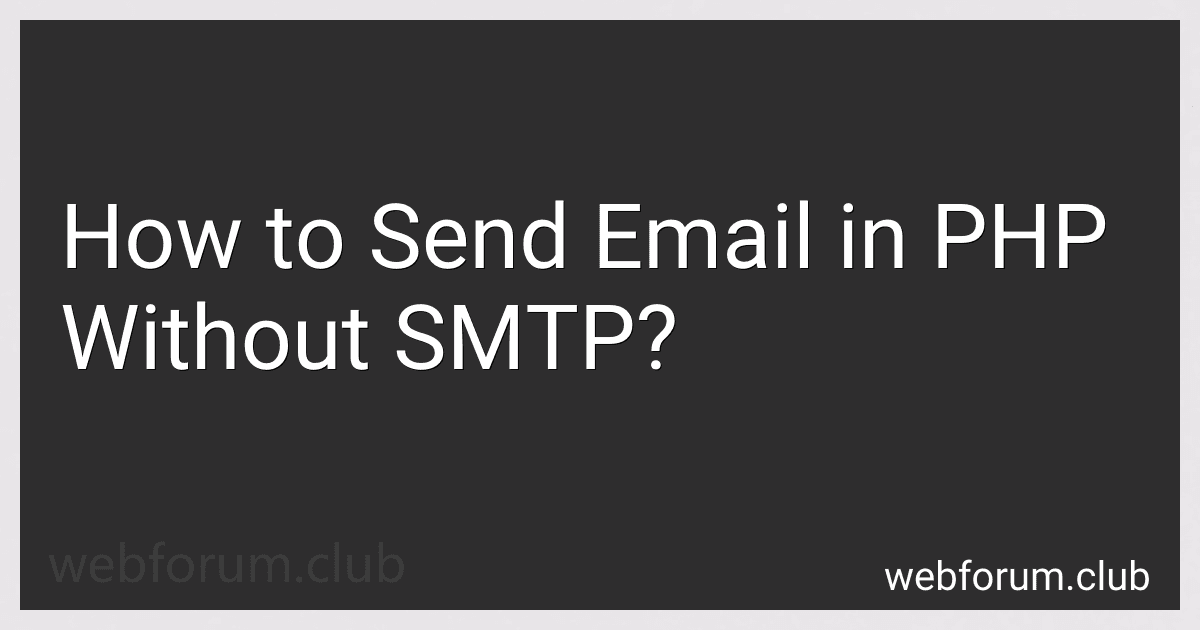PHP is a popular programming language that is widely used for web development. It is known for its simplicity, flexibility, and wide range of features. PHP can be embedded directly into HTML code and executed on the server-side, enabling dynamic content generation.
SMTP, on the other hand, stands for Simple Mail Transfer Protocol. It is a standard protocol used for sending emails over the internet. SMTP allows email clients (such as Outlook or Gmail) to communicate with email servers to send and receive emails. It handles the transmission of email messages, ensuring accurate delivery from the sender to the recipient's mail server.
When it comes to PHP and SMTP, PHP provides built-in functions and libraries for handling email communication via SMTP. These functions allow PHP developers to send emails programmatically from PHP scripts. By utilizing PHP's SMTP functionalities, developers can easily incorporate email sending capabilities into their web applications or websites.
PHP's SMTP functionalities enable developers to define various email attributes, such as the sender's address, recipient's address, subject, and message content. They can also specify the SMTP server details, including the address, port, authentication credentials, and encryption settings.
Furthermore, PHP's SMTP capabilities enable developers to handle email attachments, including files, images, or other data, making it easier to send complex email messages with attachments.
In summary, PHP and SMTP integration allows developers to incorporate email sending capabilities into their PHP applications by utilizing SMTP's standard protocol for transmitting email messages over the internet. PHP's built-in functions and libraries provide the necessary tools to send emails programmatically, making it convenient and efficient to handle email communication in PHP-based web applications.
How to send email in PHP?
To send emails using PHP, you need to follow these steps:
- Set up an SMTP server: You need to have an SMTP (Simple Mail Transfer Protocol) server configured on your web server or use a third-party SMTP service. Popular options include Gmail SMTP, SendGrid, and Mailgun.
- Enable the PHP mail() function: Check if the mail() function is enabled in your PHP configuration. You can do this by checking the php.ini file or contacting your hosting provider.
- Create a form or compose the email: You need to create an HTML form with input fields for recipient email, subject, and message. Alternatively, you can directly create the email using PHP variables.
- Handle the form submission: Once the form is submitted, process the input values and store them in variables.
- Use the mail() function: Use the mail() function to send the email. Pass the recipient email, subject, message, and optionally additional headers as arguments.
Here's an example of PHP code to send email using mail() function:
In the above example, replace recipient@example.com and sender@example.com with the actual email addresses. Make sure that the From and Reply-To addresses belong to your domain to avoid spam filters. Additionally, you can use the headers variable to set additional headers such as Cc, Bcc, or Content-Type.
Remember to test your code thoroughly to ensure successful email delivery.
How to send email in PHP without SMTP?
To send an email in PHP without using SMTP, you can utilize the mail() function which is built-in and available in most PHP installations. Here's an example of how you can use it:
$to = 'recipient@example.com'; $subject = 'Testing Email'; $message = 'This is a test email sent without SMTP.'; $headers = 'From: sender@example.com' . "\r\n" . 'Reply-To: sender@example.com' . "\r\n" . 'X-Mailer: PHP/' . phpversion();
if (mail($to, $subject, $message, $headers)) { echo 'Email sent successfully.'; } else { echo 'Failed to send email.'; }
In the above code, replace recipient@example.com with the email address of the recipient, and sender@example.com with the email address the email will be sent from. The mail() function takes four parameters: the recipient's email address, the subject of the email, the message content, and the headers.
Note that using mail() relies on the server's email configuration, and it may not work properly on all systems. Additionally, the method does not provide features like authentication and secure transmission, which are offered by SMTP.
